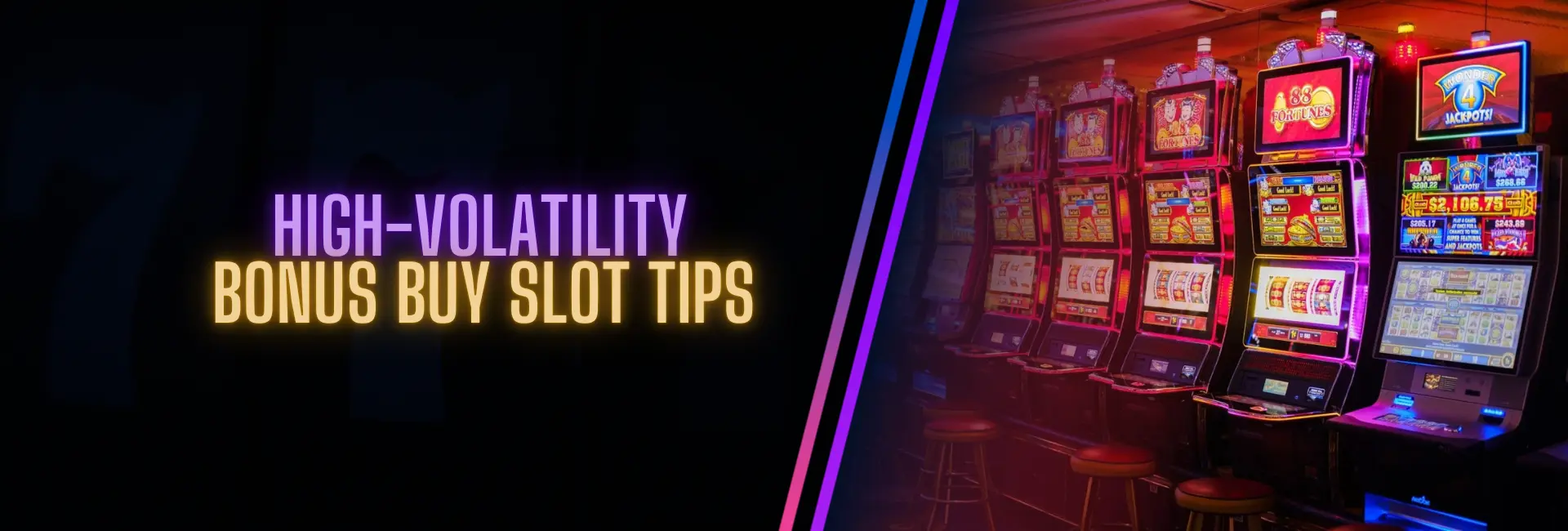
🌪️ High‑Volatility Bonus Buy Slot Tips
| ⚡️ Parameter | 📊 Suggested Range | 🏆 Why It Matters |
| Bankroll buffer | 250×–500× feature cost | Survives 20+ dry bonuses |
| Session slice | 5 %–8 % of total roll | Limits catastrophic tilt |
| Stop‑loss | ‑35 % session stake | Prevents “double‑or‑bust” spirals |
| Cash‑out trigger | +200 % session stake | Locks profits before variance bites |
| Cool‑off break | 30 min per 10 buys | Resets decision‑making |
Core idea: High‑volatility bonus buys compress months of spins into seconds. These high volatility bonus buy tips keep you in the game long enough for the math to catch up – and hopefully unleash those 10 000× monsters.
🔍 What Makes a Bonus Buy “High Volatility”?
A feature crosses the high‑volatility line when one or more of these boxes tick:
- Buy‑in excess of 200× stake.
- Hit distribution is ultra‑skewed: >90 % of bonuses return under 50×, <0.1 % hit 1 000×+.
- RTP cliff: Bonus‑only RTP at least 0.5 % lower than base + bonus combined.
Slots like Money Train 4, Wanted Dead or a Wild VS bonus, and Dog House Multihold Super are poster children. They dangle eye‑watering caps (20 000× – 100 000×) but bury them behind barren streaks. Recognising the volatility fingerprint is Step 1 in any high‑risk bonus buy strategy.
💰 Bankroll Architecture: Build a Fortress, Not a Tent
Minimum Capital Formula
Total Bankroll = Feature Cost × 400
Why 400×? Monte‑Carlo sims show that a 400× buffer gives a 90 % chance of avoiding total ruin over 1 000 high‑volatility buys at 95 % RTP. Drop to 200× and bust risk climbs above 25 % – too spicy for most pockets.
Session Slicing
Allocate 5 % – 8 % of your roll per sitting. For a €10 feature, a €4 000 bankroll means €200 – €320 session ammo – enough for 20 – 32 buys. That window balances exposure with time on device: you’ll witness variance but have a floor below bust.
These bankroll guardrails form the spine of every other tip in this guide.
🏗️ Staking Ladders That Respect Variance
Not all progression systems are kamikaze. Two that pair well with high‑volatility bonus buys:
- Reverse Labouchère (Positive Cancellation)
- Start with a low series, e.g., 1‑1‑2‑3.
- Add numbers after wins, cancel after losses.
- A long drought resets the ladder before stakes get nuclear.
- Parachute Ladder
- Begin at Base Stake.
- Climb one step after each profit >+50 %.
- Drop two steps after any loss.
- The “parachute” ensures you drift down faster than you ascend.
Rule: Never let a ladder step exceed 10 % of session slice. That keeps any single buy from nuking your mental state.
⏱️ Session Pacing: Why Time Is a Bankroll Tool
High‑risk features deliver emotional whiplash. Injecting structured pauses dials down cortisol and improves decision quality.
- 10‑Buy Blocks: Play ten features, then enforce a 5‑minute stand‑up. Review ROI, hydrate, tweak stake if required.
- 30‑Minute Tech Alarms: Smartphones or browser extensions pop a reminder – override only if ROI > +50 % and mental state feels stable.
- Scheduled Cool‑offs: After three blocks, take 30 minutes away. Variance won’t reset, but your bias will.
Add “Break” into your log; future you will see patterns between fatigue and ROI dips.
🛡️ Risk‑Mitigation Arsenal
| 🧰 Tool | 🔑 Function | 📈 ROI Impact |
| Reality Checks | Pop‑ups with elapsed time & P/L | Cuts impulse buys |
| Loss‑Limit Caps | Hard ceiling on daily deposits | Prevents ruin cycles |
| Auto Withdrawals | Push profits to second wallet | Locks gains outside reach |
| RTP Filters | Block <95 % titles | Trims long‑run house edge |
| Streamer Mode Off | Hides viewer chat hype | Reduces FOMO decisions |
Stacking 3–4 of these tools raises survival odds dramatically.
📊 Data‑Driven Target Setting
The 1 000‑Buy Benchmark
Analysing 1 000 Money Train 4 Super buys at €0.50:
- Cost: €500 × 1 000 = €500 000
- Return: €482 700
- ROI: ‑3.5 % (near its 96.5 % RTP)
Yet within that sample, ROI fluctuated between ‑42 % and +68 % due to epic hits. This rollercoaster underpins every high volatility bonus buy tips list: wins arrive in spikes, not drips.
Personal Thresholds
- Happy Stop‑Win: Cash out when current ROI ≥ +60 % – big spikes rarely repeat in the same session.
- Red Flag Loss: If ROI ≤ ‑30 % after 15 buys, downshift stake or tap out. Probability of recovery inside the slice drops below 25 %.
🔗 Slot‑Specific Tactics
- Money Train 4 – Persistent Scout FirstThe cheapest persistent symbol (Scout) costs 300× vs. 500× for Necromancer. Starting lower volatility inside a high‑volatility game stretches sample size.
- Wanted Dead or a Wild – Dual Buy MixAlternate VS Bonus (200×) with Dead Bonus (100×) at a 1:2 ratio. This lowers average cost to 133×, smoothing variance without ditching max win potential.
- Dog House Multihold – Warm‑Up SpinsRun 50 base spins before each buy. Sticky wild counts can preload reels, nudging bonus outcomes without major extra cost.
🧑💻 Tracking Software & Templates
- Notion “High‑Volatility Lab” Database template: inputs for cost, payout, ladder step, mood, break times.
- Google Sheets Script: Auto‑colour ROI column red below ‑25 %, green above +25 %.
- Graphical Heat Maps: Visualise streaks; clusters of red flag a tilt danger zone.
Download our free template (coming soon) to anchor your high‑risk bonus buy strategy in cold data.
🌡️ Psychology: Managing Adrenaline & Tilt
High‑volatility buys light up the brain’s reward circuits. Use these hacks:
- Heartbeat Check: Wear a smartwatch; if BPM > 120 during calm, pause play. Elevated heart rate correlates with impulsive stake jumps.
- Gamify Loss Limits: Treat staying within stop‑loss as “winning the meta‑game.” Reward yourself with coffee, music break, etc.
- Post‑Win Downtime: After any payout >500×, stop for 15 minutes. Dopamine spikes impair risk assessment for up to 20 minutes.
Mastering emotional variance is the stealth key behind every technical tip.
🚀 Ethical ROI Boosters (High‑Volatility Edition)
- Rakeback Loops: Some crypto casinos offer 10 % instant rakeback – recouping part of the inflated cost.
- Bonus Buy Leaderboards: When leaderboards compile biggest multipliers per stake rather than raw win, low bets can still snag prizes, effectively overlaying extra RTP.
- Promo RTP Overlays: New‑slot launch weeks occasionally boost RTP to 98 %. Stack that with high‑volatility potential for rare positive EV moments.
Use boosters cautiously – they trim the edge but can lure you into over‑length sessions if misread.
📚 Myth‑Busting Corner
| ❌ Myth | ✅ Reality |
| “Max bet raises hit rate.” | Bet size scales payouts, not probabilities. |
| “Streams show real outcomes.” | Many streamers use promo funds or edited reels. |
| “Two dead bonuses mean a win is due.” | RNG has no memory; odds reset each spin. |
| “Lower stake = lower risk.” | Risk scales with cost multiplier, not stake size alone. |
Killing myths early saves thousands in lost bankroll.
📈 Case Study: Surviving 30 Cold Buys
We tracked a player with €10 000 bankroll tackling Wanted Dead or a Wild VS bonus at €1 stake (200× cost = €200 each). First 30 buys all paid <30× – total return €660, ‑67 % session ROI. Player followed this playbook:
- Hit predefined stop‑loss (‑35 % slice) at buy #18, paused play for two days.
- Returned at lower ladder step (‑20 % stake) using Parachute Ladder.
- Landed 3 500× win on buy #37, restoring bankroll to €9 800.
- Cashed out profit above €9 500, ending month at ‑5 % total ROI instead of bust.
Lesson: adherence to stop‑loss and stake ladders cushions brutal variance until probability serves the outlier hit.
❓ Frequently Asked Questions
How many high‑volatility buys should I run before judging a slot?
Minimum 500 buys; below that, variance masks true RTP.
Is it worth buying lower‑volatility features in the same game?
Yes – mixing cost tiers reduces drawdown and extends playtime.
Can staking systems beat the house edge?
No – they only pace risk and emotion; RTP remains unchanged.
What’s the safest cool‑off interval?
At least 15 minutes every hour or after any payout >500× stake.




